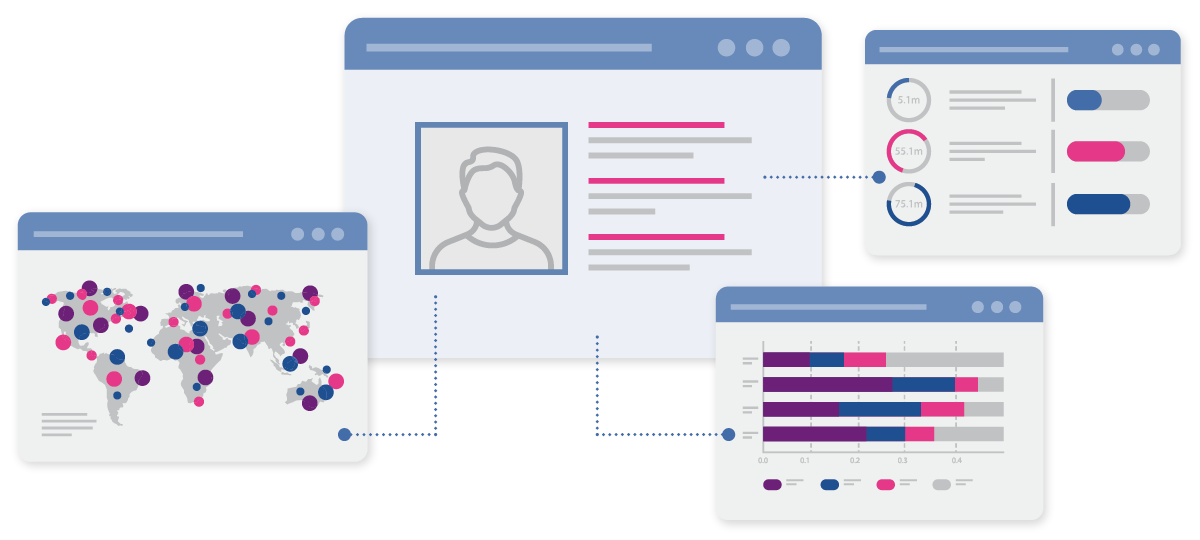Since we published this guidance, Google announced on 22 July 2024 that it will not fully phase out third-party cookies. The guidance in this post, however, remains relevant.
While Google’s third-party cookies remain in use, users can opt out, meaning advertisers will continue to face limitations. As a result, it’s important for marketers to reduce reliance on cookies by diversifying their data strategies. For more on these recent changes, see our article on Google’s cookie developments.
Digital advertising is undergoing a profound transformation thanks to the ongoing deprecation of third-party cookies. Marketers now find themselves at a critical junction where innovation and adaptation are not just strategic choices but essential for survival in the evolving market.
What is cookieless targeting?
Cookieless targeting is the method of delivering personalised advertising without relying on traditional third-party cookies. As major browsers have started to phase out third-party cookies, the advertising industry has developed alternative methods for targeting users.
Moving forward, the importance and focus shifts towards building trusted connections with customers while traversing the marketing terrain with new, innovative methods that offer the same data-driven precision of third-party cookies.
In this guide, we review the impact of third-party cookie deprecation on digital advertising and explore six alternative solutions to third-party cookies, dissecting each of their strengths and limitations. Discover not only how to navigate but thrive in a cookieless world.
What are the alternatives for targeted marketing in a post-cookie world?
Preparing for a world without third-party cookies might seem like a huge hurdle for brands, businesses and those in digital. However, it’s important to recognise that this shift doesn’t spell the end of targeted advertising. Even without third-party cookies, outside of solutions such as Google’s Privacy Sandbox, practical solutions are available to uphold effective targeting and advertising strategies. However, there’s no one-stop solution, so marketers will need to flex their approach.
Here we look at some of the options and considerations:
1. First-party data
First-party data is information directly collected from users. It features data from various internal systems, such as marketing automation tools, customer relationship management (CRM) platforms, and visitor interactions with your website.
Pros:
 | Unique insights: Provides detailed and unique insights into actual customers, allowing for better personalisation and relationship-building. This data includes information on how customers engage with emails and websites, their buying history, and their interactions with customer contact points. |
 | Privacy compliance and trust: First-party data is collected directly from users with their consent. This direct relationship helps build trust, as customers are more likely to trust that their data is being used responsibly when they have a direct connection with the collecting entity. |
 | Cost-effective: Relying on first-party data eliminates the need to purchase third-party data. By focusing on building and utilising your own data, you can reduce costs while still engaging in effective data-driven marketing and business strategies. |
Cons:
 | Limited scope: Your data is restricted to the interactions that customers have with your brand directly. This means it may not provide a complete picture of customer behaviour, especially in relation to their activities outside of your ecosystem. This can hinder efforts to understand broader market trends or customer needs that aren’t directly observed. |
 | Inability to scale: As first-party data is limited to interactions with your own customers and prospects, it typically results in a smaller data set. Relying solely on first-party data will limit the number of consumers you can engage with and ultimately hinder scalability and organisational growth. |
 | Quality and accuracy issues: First-party data is not immune to quality issues. Data can become outdated quickly if not regularly updated, and inaccuracies can occur due to errors in data collection or entry. Maintaining the quality and relevance of data requires ongoing attention and resources. |
2. Universal IDs
A Universal ID is a specific type of identifier designed to offer a consistent and singular way of recognising users across diverse websites and digital platforms. It aims to replace the necessity for multiple, disparate cookies.
When a user visits a website that is part of a Universal ID framework, their identity—such as an email or another piece of identifying information they have agreed to share—is anonymised and transformed into a hashed or encrypted format, creating a unique and secure string of characters.
This ID is then employed across all participating websites and platforms to identify users while safeguarding their identity and personal information. This allows advertisers to recognise users compliantly across different sites.
Universal IDs provide the capability to maintain a comprehensive consumer view across various channels and platforms. This leads to improved personalisation and addressability across different channels, even in environments where cookies are not used.
Pros:
 | Cross-platform compatibility: Enables tracking of users across different devices and websites. |
 | Enhanced personalisation: By providing a stable, cross-platform user identifier, Universal IDs allow marketers to more effectively tailor their advertising and content to individual preferences and behaviours, even when cookies aren’t available. |
 | Addressability: Universal IDs ensure that advertisers can continue to reach their intended audience with relevant messaging across different devices and platforms, preserving the effectiveness of digital advertising campaigns. |
 | Privacy-conscious: Provides a privacy-friendly alternative to third-party cookies. They offer the ability to maintain a comprehensive consumer view across channels and platforms, leading to enhanced personalisation and addressability across various channels, even in cookieless environments. |
Cons:
 | Restricted reach: No universal identifier can adequately substitute third-party cookies on its own. Universal IDs are most effective when used alongside other universal IDs or alternate addressable IDs. |
 | Privacy: Thoroughly evaluating third-party data providers is crucial. It’s important to choose a provider that can clearly demonstrate their ability to navigate and adapt to the changing landscape of privacy regulations. |
3. Identity graphs
An identity graph is a database used by marketers and advertisers to understand and track the same individual across different channels and platforms. It combines personally identifiable information (PII), like a name or email address, with non-personally identifiable information (non-PII), like browsing behaviour or device type. Identity graphs aim to create a single customer profile by linking customer data from various sources using a combination of deterministic and probabilistic matching.
Pros:
 | Real-time personalisation: Identity graphs combine PII and non-PII data into a single data store, enabling real-time advertising personalisation at scale by providing advertisers with instant access to comprehensive user profiles. |
 | Cross-device and cross-channel scalability: Can be scaled relatively easily across devices and channels. This data can then be used to deliver highly personalised advertising experiences through channels like programmatic advertising. |
 | Better data integration: Identity graphs can integrate various data types (both PII and non-PII), helping businesses to consolidate their data silos into a unified customer view. This integration supports more coherent and data-driven decision-making. |
 | Higher accuracy and efficiency: By using deterministic matching, identity graphs can achieve high accuracy in identifying users, which is beneficial for precision marketing and reducing waste in advertising spend. |
Cons:
 | Privacy: Careful consideration of third-party data providers is paramount. It’s critical to select the right provider and ensure that they can demonstrate their approach to managing the evolving changes in privacy regulation. |
 | Transparency: Identity graphs aggregate data from various sources, making it challenging for users to understand how their data is being collected and used. It’s critical to ensure that the third-party data provider you’re working with has consumer transparency at the heart of the design. |
 | Implementation costs: There will be a commercial cost associated with this type of solution. If you’re looking to implement an identity graph solution, you’ll need to assess the commercial approach and business case for viability. |
4. Contextual targeting
Contextual advertising targets users based on the content of the websites they are currently visiting rather than relying on browsing history or previous behaviour.
Advanced algorithms analyse the content of a webpage to determine its themes and keywords. This can include reading the text, examining images, and understanding the overall context of the page. Once the content is analysed, the system matches ads that are relevant to the detected themes or keywords. For example, an article about running might display ads for running shoes or fitness apps. These matched ads are then displayed as the user views the page, ensuring that the advertising content is relevant to what the user is reading or viewing at that moment.
Pros:
 | Privacy-friendly: Does not rely on third-party cookies, providing effective audience activation. Contextual advertising is a type of online advertising that targets users based on the content of the websites they are currently visiting, rather than relying on the user’s browsing history or previous behaviour. |
 | Improved user experience: Ads are more likely to be related to the user’s current interests, potentially increasing engagement and reducing annoyance. |
 | Increased relevance: Ads are directly related to the content, which can lead to higher click-through rates and better conversion rates for advertisers. |
 | Scale: Contextual targeting is attractive to advertisers and publishers because it can deliver scale alongside increased relevance. |
Cons:
 | Price: Price can be considered a barrier to contextual targeting in certain circumstances. Contextual targeting is often associated with premium publishers; therefore, advertisers might need to pay higher prices to place ads on high-quality, high-traffic sites with premium content. Since these sites attract more advertisers, the competition can drive up the CPM (cost per thousand) of contextual ad placements. |
 | Limited scope: Contextual targeting may pose challenges for certain markets or brands, such as CPG (consumer packaged goods). CPG companies often have a wide range of products, each appealing to different target audiences and contexts. Managing and optimising contextual targeting for such a diverse portfolio can be complex and resource-intensive. There may also be limited scope for contextual targeting for very specific product lines e.g. everyday essentials. |
 | Unknown audience: Contextual targeting is based on browsing-only behaviours, so it is potentially less useful for advertisers who want additional audience definitions as part of their campaign, e.g., aspirational car browsing vs. those likely to buy. |
5. Cohort-based targeting
Cohort-based targeting is a marketing strategy that involves grouping individuals into cohorts based on shared characteristics, behaviours, or experiences and then targeting these groups with tailored messages and advertisements. This approach utilises the concept that individuals within the same cohort will likely respond similarly to marketing efforts due to their commonalities.
Pros:
 | Enhanced personalisation: By grouping users into cohorts with shared characteristics or behaviours, marketers can tailor their messages and offers more precisely to each group’s interests and needs. |
 | Improved resource allocation: Businesses can allocate their marketing resources more efficiently by clearly understanding which cohorts are more profitable or engaged. |
 | Compliance with privacy regulations: Cohort-based targeting reduces the reliance on individual-level data, which helps in adherence to data protection regulations. Companies can mitigate privacy concerns and build customer trust by focusing on aggregated data. |
Cons:
 | Overgeneralisation: Assumptions about a cohort based on shared characteristics can lead to overgeneralisation. Not all individuals in a cohort may respond similarly, and marketing messages may not resonate equally with everyone in the group. |
 | Risk of missing emerging trends: Focusing on pre-defined cohorts may cause marketers to miss emerging trends or new customer segments that do not fit into existing cohorts. This can limit the ability to adapt to changing market dynamics and customer behaviours. |
 | Reduced agility: Once cohorts are defined, it can be challenging to quickly adapt marketing strategies to sudden changes in the market or consumer behaviour. This rigidity can hinder the ability to respond swiftly to new opportunities or threats. |
6. Data collaboration
Data collaboration sees different organisations share and merge their datasets to create a comprehensive view of user groups with similar interests and behaviours without relying on invasive individual tracking. This method allows for more effective targeting and analysis while respecting user privacy.
Pros:
 | Improved connectivity: Data collaboration enhances connectivity between partners and their data sets by grouping users with similar interests and behaviours. |
 | Privacy-conscious: Offers a privacy-conscious alternative to individual tracking. In a cookieless world, it becomes more difficult for companies to “communicate” with one another. We expect to see more data collaboration in the market, using addressable IDs and identity resolution to power connectivity between partners and their data sets. |
Cons:
 | Data security risks: While data collaboration can enhance consumer data and inform strategies, it can also introduce potential data security risks if not done within the right framework. |
 | Matching challenges: This may lead to subpar matching results due to issues like data hygiene or identifier discrepancies. |
 | Scale: When data is layered and combined, there can be an impact on scale. This leaves advertisers with an ineffective solution and potentially unable to deliver their campaign. |
The alternative targeting methods have limitations, but we can help
While it’s promising to see numerous alternatives to cookies emerging, it’s essential to recognise that each alternative has limitations and is not a perfect one-to-one replacement for third-party cookies.
As a leader in data and identity solutions, we’ve developed an innovative strategy to overcome the limitations of alternative targeting methods and address the challenges that the shift away from third-party cookies presents. Our Consumer Sync solution is designed to seamlessly adapt to these changes, setting you up for success in a cookieless environment and helping you navigate the transition away from third-party cookies.
By combining first-party and third-party data across platforms and devices in a privacy-conscious manner, Consumer Sync enables you to maintain addressability without compromising user privacy. It’s an interoperable linkage solution that connects and resolves a vast range of offline and online signals, channels, and devices at scale within a single household.

With coverage spanning over 55% of UK households and access to more than 120 million digital identifiers, Consumer Sync offers brands, agencies and publishers the scale needed to reach untapped audiences and boost campaign performance. By layering authenticated and unauthenticated audiences with rich demographic insights, Consumer Sync enables tailored personalisation.
Whilst a world without third-party cookies might seem like a huge hurdle, it also presents challenges and opportunities for innovation in digital advertising. We’re here to help you navigate this transition and move forward effectively in this new data landscape.
Thrive in a cookieless environment
Consumer Sync enables you to understand, activate, and measure your audience with precision and scalability, empowering targeted campaigns and informed decisions without relying on traditional cookie-based methods.
Chat with one of our experts to find out more.











